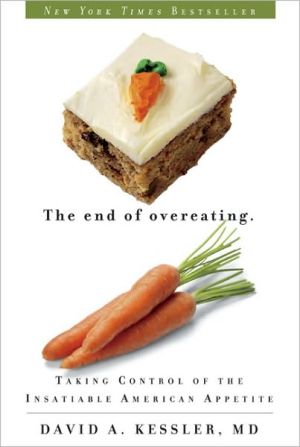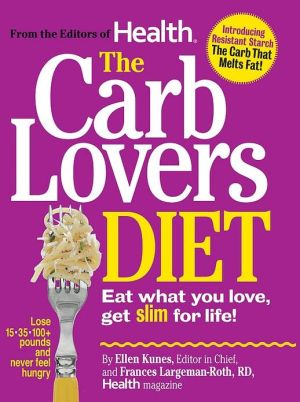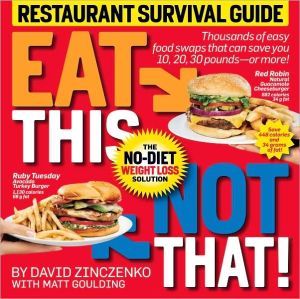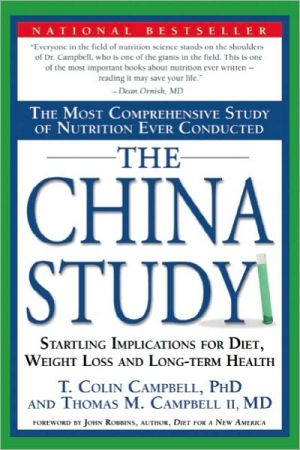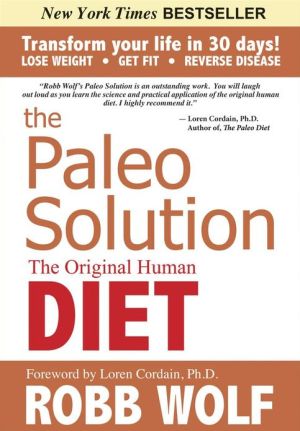The End of Overeating: Taking Control of the Insatiable American Appetite
Drawn from the latest brain science as well as interviews with top physicians and food industry insiders, The End of Overeating uncovers the food industry's aggressive marketing tactics and reveals shocking facts about how we lost control over food-and what we can do to get it back. For the millions of people struggling to lose weight as well as those of us who simply can't seem to eat our favorite foods in moderation, Dr. Kessler's cutting-edge investigation offers valuable insights and...
Search in google:
Most of us know what it feels like to fall under the spell of food—when one slice of pizza turns into half a pie, or a handful of chips leads to an empty bag. But it’s harder to understand why we can't seem to stop eating—even when we know better. When we want so badly to say "no," why do we continue to reach for food?Dr. David Kessler, the dynamic former FDA commissioner who reinvented the food label and tackled the tobacco industry, now reveals how the food industry has hijacked the brains of millions of Americans. The result? America’s number-one public health issue. Dr. Kessler cracks the code of overeating by explaining how our bodies and minds are changed when we consume foods that contain sugar, fat, and salt. Food manufacturers create products by manipulating these ingredients to stimulate our appetites, setting in motion a cycle of desire and consumption that ends with a nation of overeaters. The End of Overeating explains for the first time why it is exceptionally difficult to resist certain foods and why it’s so easy to overindulge.Dr. Kessler met with top scientists, physicians, and food industry insiders. The End of Overeating uncovers the shocking facts about how we lost control over our eating habits—and how we can get it back. Dr. Kessler presents groundbreaking research, along with what is sure to be a controversial view inside the industry that continues to feed a nation of overeaters—from popular brand manufacturers to advertisers, chain restaurants, and fast food franchises.For the millions of people struggling with weight as well as for those of us who simply don't understand why we can't seem to stop eating our favorite foods, Dr. Kessler’s cutting-edge investigation offers new insights and helpful tools to help us find a solution.There has never been a more thorough, compelling, or in-depth analysis of why we eat the way we do. Publishers Weekly "Conditioned hypereating is a biological challenge, not a character flaw," says Kessler, former FDA commissioner under presidents Bush and Clinton). Here Kessler (A Question of Intent) describes how, since the 1980s, the food industry, in collusion with the advertising industry, and lifestyle changes have short-circuited the body's self-regulating mechanisms, leaving many at the mercy of reward-driven eating. Through the evidence of research, personal stories (including candid accounts of his own struggles) and examinations of specific foods produced by giant food corporations and restaurant chains, Kessler explains how the desire to eat-as distinct from eating itself-is stimulated in the brain by an almost infinite variety of diabolical combinations of salt, fat and sugar. Although not everyone succumbs, more people of all ages are being set up for a lifetime of food obsession due to the ever-present availability of foods laden with salt, fat and sugar. A gentle though urgent plea for reform, Kessler's book provides a simple "food rehab" program to fight back against the industry's relentless quest for profits while an entire country of people gain weight and get sick. According to Kessler, persistence is all that is needed to make the perceptual shifts and find new sources of rewards to regain control. (May)Copyright © Reed Business Information, a division of Reed Elsevier Inc. All rights reserved.
Can Canada Put on the Brakes?\ \ \ I walked into Jack Astor’s Bar & Grill in Toronto, an energetic place that draws a young crowd and entertains them with loud music and multiple television monitors. A sign advertised a restaurant gift card: “a gift for every craving.”\ \ The dinner menu descriptions had an over-the-top quality that reminded me of Chili’s, including ultimate nachos, with their “bubbling blend of cheeses,” and a bacon cheeseburger.\ \ I ordered two items from the “start-up” list. The lobster and crab dip was a warm, fatty blend dominated by cream cheese. The Southwest grilled chicken flatbread, with its four-cheese blend and smoky chipotle aioli, was a dish of fat on fat on refined carbohydrates, accompanied by a little protein. There were two flatbreads to an order, each about 10.5 inches long.\ \ My entrée, crispy honey sesame chicken, consisted of fried chicken balls with a substantial portion of vegetables, covered in a sweet sauce. Fat, sugar, and salt had been layered and loaded onto the dish.\ \ But for all that, the food at Jack Astor’s stopped somewhat short of its American counterparts. The preparations had less of an industrial quality. The dishes were cooked to order on site, not par-fried, frozen, and shipped across the country. There weren’t as many fried chicken balls on my dinner plate, and they weren’t as large.\ \ I saw that kind of contrast everywhere I looked in Canada. Swiss Chalet offered an all-you-can-eat lunch, a garlic cheese loaf “smothered in melted Jack and cheddar,” and a waiter who assured me that “everythingcomes with dipping sauce.” But portion sizes were a trifle smaller than is typical in the United States and there was a homemade quality to most of the food. At Caroline’s Cheesecake, there were fewer choices than at the Cheesecake Factory, but the portions seemed about as big. The Pickle Barrel had a lot of healthy-sounding food on its menu, but it also served a “triple threat chocolate sundae,” a “mammoth Oreo cookie sundae,” and lemon cranberry and apple cinnamon muffins that were the size of grapefruits.\ \ Canada, it seems, is headed in a troubling direction as the ingredients of conditioned hypereating are assembled. Things aren’t as bad here as they are in the United States, but they aren’t good. One out of four Canadians is now obese, compared to one in three in the U.S. One-third of Canadians who were classified as normal weight a decade ago are now overweight. The upward curve is especially evident in the younger population, with the number of overweight and obese children, ages 7 to 13, increasing by as much as 300% in just two decades.\ \ Human physiology and conditioning are, of course, the same in both countries, so social norms and the environment offer the only possibilities of arresting these trends. It is as if a great natural experiment is being conducted in Canada.\ \ An earlier generation of Canadians recalls a time when eating in restaurants was a rare event and snacking in the street was considered crass. One colleague told me how his father used to love visiting U.S. supermarkets because he was awed by how many more varieties of breakfast cereal were available. Even today, despite changing patterns and the growth of chain restaurants across the country, food is still not quite so ubiquitous or indulgent in Canada. The limitations that once disappointed Canadians may yet save them from the consequences its more overindulgent neighbor is facing.\ \ Nonetheless, candy cane donuts and sour cream donuts are now available at Tim Horton’s, and the small donut balls known as “Timbits” are one of the store’s especially popular features. Even the upscale restaurant, Milestone’s, serves an array of sweet and fatty dipping sauces with its Cajun popcorn shrimp, seafood mixed grill, and yam fries. And the Quebecois tradition of poutine– French fries covered with cheese curds and brown gravy–has gained traction, with many fast-food restaurants in all of the provinces adding it to their menus. Swiss Chalet gives me the opportunity to “poutinize” my fries for $1.99.\ \ Still, Canada has an opportunity to recognize the trajectory it is on and change course. A publishing professional I met there suggested how it might be done when he confessed to his struggle over Kit Kats. A large, tightly disciplined man, he told me that every evening as he heads to the train for his ride home, he breaks into a run to get safely past a news stand that sells those crispy chocolate wafers. Canada, too, must figure out the direction it needs to start running in order to avoid calamity.\ \ When I asked the manager of Jack Astor’s about portion sizes, he told me, “They’re bigger than they have to be. But it’s not like Cheesecake Factory.”\ \ The question is whether it will stay that way.
Foreword xiIntroduction: You Are the Target xvPart 1 Sugar, Fat, Salt1 Something Changed … America Gained Weight 32 Overriding the Wisdom of the Body 73 Sugar, Fat, and Salt Make Us Eat More Sugar, Fat, and Salt 124 The Business of Food: Creating Highly Rewarding Stimuli 185 Pushing Up Our Settling Points 226 Sugar, Fat, and Salt Are Reinforcing 297 Amping Up the Neurons 358 We Are Wired to Focus Attention on the Most Salient Stimuli 419 Rewarding Foods Become Hot Stimuli 4610 Cues Activate Brain Circuits That Guide Behavior 5011 Emotions Make Food Memorable 5512 Rewarding Foods Rewire the Brain 5813 Eating Behavior Becomes a Habit 61Part 2 The Food Industry14 A Visit to Chili's 6715 Cinnabon: A Lesson in Irresistibility 7416 That's Entertainment 7817 The Era of the Monster Thickburger 8318 No Satisfaction 9419 Giving Them What They Like 9720 What Consumers Don't Know 10121 The Ladder of Irresistibility 10422 The World's Cuisine Becomes Americanized 11123 Nothing Is Real 11524 Optimize It! 12025 The Science of Selling 12526 Purple Cows 132Part 3 Conditioned Hypereating Emerges27 Overeating Becomes More Dangerous 13728 What Weight-Loss Drugs Can Teach Us 14229 Why We Don't Just Say No 14530 How We Become Trapped 15431 Conditioned Hypereating Emerges 15732 Tracing the Roots of Conditioned Hypereating 16333 Nature or Nurture? 16634 Warning Signs in Children 16935 The Culture of Overeating 173Part 4 The Theory of Treatment36 Invitations to the Brain 18137 Reversing the Habit 18438 Rules of Disengagement 19039 Emotional Learning 196Part 5 Food Rehab40 The Treatment Framework 20541 Planned Eating 20942 Letting Go of the Past 21743 Eating Is Personal 22644 Avoiding Traps: On Obsession and Relapse 23145 Making the Critical Perceptual Shift 234Part 6 The End of Overeating46 "Our Success Is the Problem" 23947 Industry Cracks the Code 24248 Fighting Back 245A Final Word 250Q&A with Dr. Kessler 253Endnotes 257List Of Author Interviews 311Acknowledgments 319Index 323About The Author 330
\ Publishers Weekly"Conditioned hypereating is a biological challenge, not a character flaw," says Kessler, former FDA commissioner under presidents Bush and Clinton). Here Kessler (A Question of Intent) describes how, since the 1980s, the food industry, in collusion with the advertising industry, and lifestyle changes have short-circuited the body's self-regulating mechanisms, leaving many at the mercy of reward-driven eating. Through the evidence of research, personal stories (including candid accounts of his own struggles) and examinations of specific foods produced by giant food corporations and restaurant chains, Kessler explains how the desire to eat-as distinct from eating itself-is stimulated in the brain by an almost infinite variety of diabolical combinations of salt, fat and sugar. Although not everyone succumbs, more people of all ages are being set up for a lifetime of food obsession due to the ever-present availability of foods laden with salt, fat and sugar. A gentle though urgent plea for reform, Kessler's book provides a simple "food rehab" program to fight back against the industry's relentless quest for profits while an entire country of people gain weight and get sick. According to Kessler, persistence is all that is needed to make the perceptual shifts and find new sources of rewards to regain control. (May)\ Copyright © Reed Business Information, a division of Reed Elsevier Inc. All rights reserved.\ \ \ \ \ From the Publisher"Dr. David Kessler has written a fascinating account of the science of human appetite, as well as its exploitation by the food industry. The End of Overeating is an invaluable contribution to the national conversation about the catastrophe that is the modern American diet." --Michael Pollan, author of In Defense of Food\ "David A. Kessler, who led the battle against the tobacco industry, now joins the fight against obesity. His message is important: The problem is not only the behavior of profit-driven food companies, but also the daily choices that each one of us makes." —Eric Schlosser, author of Fast Food Nation\ "David Kessler’s fascinating book is essential for anyone interested in learning more about how corporate greed and human psychology have created a national health crisis." —Alice Waters, chef and owner of Chez Panisse\ "Disturbing, thought-provoking, and important." —Anthony Bourdain, author of Kitchen Confidential\ "A compelling book about overeating and the obesity pandemic. Dr. Kessler thoroughly examines the nature of our relationship with food and why it is critical to understand and modify our behavior to reverse this global threat to health and well-being." —David Satcher, former Surgeon General and director of the Centers for Disease Control and Prevention\ "A fascinating, unique book by a brilliant public health leader." —Donna Shalala, former Secretary of the U.S. Department of Health and Human Services\ \ \
